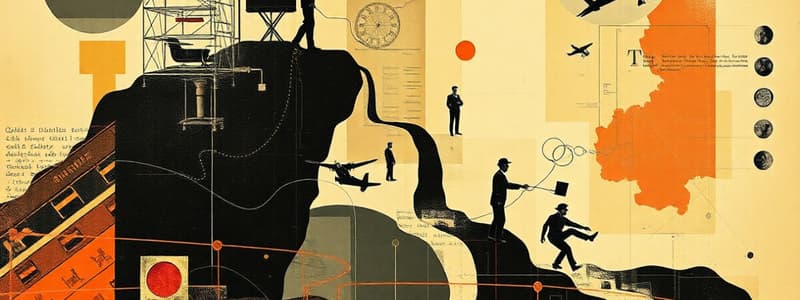Podcast
Questions and Answers
What is a software process model?
What is a software process model?
An abstract representation of a software process, presenting a description from a particular perspective.
A process activity model primarily shows the roles of the people involved rather than the sequence of activities.
A process activity model primarily shows the roles of the people involved rather than the sequence of activities.
False (B)
Distinguish between plan-driven and agile software processes.
Distinguish between plan-driven and agile software processes.
Plan-driven processes involve planning all activities in advance and measuring progress against that plan. Agile processes involve incremental planning and are designed to easily accommodate changing requirements.
List the main phases of the traditional waterfall model in order.
List the main phases of the traditional waterfall model in order.
What is incremental development?
What is incremental development?
What are two main problems associated with incremental development?
What are two main problems associated with incremental development?
Which of the following are types of software components commonly used in a reuse-oriented process?
Which of the following are types of software components commonly used in a reuse-oriented process?
What is a significant drawback of reuse-oriented software engineering related to requirements?
What is a significant drawback of reuse-oriented software engineering related to requirements?
What are the four basic process activities common to most software processes?
What are the four basic process activities common to most software processes?
What are the four main stages of the requirements engineering process?
What are the four main stages of the requirements engineering process?
What is the final output of the software specification activity?
What is the final output of the software specification activity?
What is the difference between software design and software implementation?
What is the difference between software design and software implementation?
Match the design activity with its description:
Match the design activity with its description:
What are the three main stages of testing shown in the sequential model?
What are the three main stages of testing shown in the sequential model?
What is another name for acceptance testing, especially when developing custom systems for a single client?
What is another name for acceptance testing, especially when developing custom systems for a single client?
What is Beta testing?
What is Beta testing?
What is software evolution?
What is software evolution?
Change is generally avoidable in large software projects if planned carefully.
Change is generally avoidable in large software projects if planned carefully.
What is software prototyping?
What is software prototyping?
What is the difference between incremental development and incremental delivery?
What is the difference between incremental development and incremental delivery?
What is a key characteristic of Boehm's spiral model?
What is a key characteristic of Boehm's spiral model?
What are the three perspectives from which the Rational Unified Process (RUP) is typically described?
What are the three perspectives from which the Rational Unified Process (RUP) is typically described?
Match the RUP phase with its primary goal:
Match the RUP phase with its primary goal:
What is the purpose of the 'Business modelling' workflow in RUP?
What is the purpose of the 'Business modelling' workflow in RUP?
Name two 'good practices' suggested by the Rational Unified Process (RUP).
Name two 'good practices' suggested by the Rational Unified Process (RUP).
Flashcards
Software process model
Software process model
An abstract way software processes are represented.
Plan-driven processes
Plan-driven processes
Processes where all activities are planned in advance.
Agile processes
Agile processes
Processes with incremental planning that adapts to satisfy changing customer needs.
Waterfall model
Waterfall model
Signup and view all the flashcards
Incremental development
Incremental development
Signup and view all the flashcards
Reuse-oriented software engineering
Reuse-oriented software engineering
Signup and view all the flashcards
Web services
Web services
Signup and view all the flashcards
Collections of objects
Collections of objects
Signup and view all the flashcards
Stand-alone software systems
Stand-alone software systems
Signup and view all the flashcards
Software specification
Software specification
Signup and view all the flashcards
Feasibility study
Feasibility study
Signup and view all the flashcards
Requirements elicitation and analysis
Requirements elicitation and analysis
Signup and view all the flashcards
Requirements specification
Requirements specification
Signup and view all the flashcards
Requirements validation
Requirements validation
Signup and view all the flashcards
Software Design
Software Design
Signup and view all the flashcards
Implementation
Implementation
Signup and view all the flashcards
Architectural design
Architectural design
Signup and view all the flashcards
Interface design
Interface design
Signup and view all the flashcards
Component design
Component design
Signup and view all the flashcards
Database design
Database design
Signup and view all the flashcards
Software validation
Software validation
Signup and view all the flashcards
Acceptance testing
Acceptance testing
Signup and view all the flashcards
Beta testing
Beta testing
Signup and view all the flashcards
Software Evolution
Software Evolution
Signup and view all the flashcards
Rework
Rework
Signup and view all the flashcards
Software Prototyping
Software Prototyping
Signup and view all the flashcards
Incremental Delivery
Incremental Delivery
Signup and view all the flashcards
Spiral Model
Spiral Model
Signup and view all the flashcards
Rational Unified Process
Rational Unified Process
Signup and view all the flashcards
Inception (RUP)
Inception (RUP)
Signup and view all the flashcards
Elaboration (RUP)
Elaboration (RUP)
Signup and view all the flashcards
Construction (RUP)
Construction (RUP)
Signup and view all the flashcards
Transition (RUP)
Transition (RUP)
Signup and view all the flashcards
Testing (RUP)
Testing (RUP)
Signup and view all the flashcards
Deployment (RUP)
Deployment (RUP)
Signup and view all the flashcards
Study Notes
- Software processes are the activities involved in producing a software system.
Software Process Models
- Software process models are abstract representations of software processes.
- Process activity models show activities and their sequence, but may not show the people involved.
- Common process activities include specifying a data model and user interface design.
Plan-driven and Agile Processes
- Plan-driven processes plan all activities in advance, tracking progress against the plan.
- Agile processes incrementally plan and easily change the process.
- In practice, most processes include elements of both approaches.
- There are no right or wrong software processes.
Waterfall Model
- The waterfall model includes requirements definition, system and software design, implementation and unit testing, integration and system testing, and operation and maintenance.
Incremental Development
- This approach interleaves specification, development, and validation activities
- The system is developed as a series of versions (increments), with each version adding functionality to the previous version.
- Incremental software development is better than a waterfall approach for most business, e-commerce, and personal systems.
- Concurrent activities include specification, development, and validation creating initial, intermediate, and final versions.
- Managers need deliverables to measure progress, quick system development may not be cost-effective if documentation is required.
- The system structure degrades as new increments are added.
Reuse-Oriented Software Engineering
- Stages include: requirements specification, component analysis, requirements modification, system design with reuse, development, and integration, and system validation
- There are three types of software components:
- Web services developed according to service standards and available for remote invocation,
- Collections of objects developed as a package to be integrated with a component framework such as .NET or J2EE
- Stand-alone software systems configured for use in a particular environment, like word processing or a spreadsheet
- Advantages include reducing the amount of software to develop, and reducing costs and risks.
- It usually leads to faster software delivery.
- Requirements compromises are inevitable and may lead to systems not meeting users' needs.
- There is some control lost in the system evolution as new versions of reusable components are not under the control of the organization using them.
Process Activities
- Real software processes are inter-leaved sequences of technical, collaborative, and managerial activities.
- The overall goal is to specify, design, implement, and test a software system.
- Four basic process activities of specification, development, validation, and evolution are organized differently in different development processes.
- In the waterfall model, activities are organized in sequence, whereas in incremental development they are interleaved.
Software Specification - 1
- This includes establishing services required and the constraints on the system's operation and development.
- The requirements engineering process includes feasibility study, requirements elicitation and analysis, requirements specification, and requirements validation.
- Feasibility Study: Is it technically and financially feasible to build the system?
- Requirements Elicitation and Analysis: What do the system stakeholders require or expect?
- Requirements Specification: Define the requirements in detail.
- Requirements Validation: Check the validity of the requirements.
- Final output of the specification activity of the software process is Requirements Document.
Software Design and Implementation
- Software design includes designing a software structure that realises the specification
- Implementation includes translating this structure into an executable program;
- Design and implementation activities are closely related and may be inter-leaved.
- Activities include architectural design, interface design, component design and database design.
Design Activities
- Architectural design identifies the overall structure of the system
- Principal components are sometimes called sub-systems or modules, their relationships, and how they are distributed.
- Interface design: defining the interfaces between system components
- Component design: how each system component will operate
- Database design: design system data structures and how these are to be represented in a database
Testing and Validation
- Alpha testing (acceptance testing) is for custom systems, being developed for a single client.
- The alpha testing process continues until the system developer and the client agree that the delivered system is an acceptable implementation of the requirements.
- Beta testing is used when a system is to be marketed as a software product.
- Beta testing delivers a system to a number of potential customers who agree to use that system.
Software Evolution - 4
- Software evolution takes place when existing software systems are changed to meet new requirements. The software must evolve to remain useful.
Coping with Change
- Change is inevitable in all large software projects.
- Business changes lead to new and changed system requirements.
- New technologies open up new possibilities for improving implementations.
- Changing platforms require application changes
- Costs of change include both rework and implementing new functionality.
Software Prototyping
- Benefits include:
- Improved system usability;
- Closer match to user needs;
- Improved design quality;
- Improved maintainability;
- Reduced development effort.
- Process of prototype development:
- Establish Prototype Objectives, Prototyping Plan
- Define prototype functionality, Outline definition
- Develop prototype, Executable prototype
- Evaluate prototype, Evaluation report
Incremental Development and Delivery
- Develop the system in increments and evaluate each increment before proceeding to the development of the next increment.
- This is normal approach used in agile methods.
- Evaluation is done by user/customer proxy.
- Incremental Delivery Process:
- Deploy an increment for use by end-users;
- A realistic evaluation is provided about practical software use.
- A difficult process to implement of replacement systems as increments have less functionality than the system being replaced.
Boehm's Spiral Model of the Software Process
- The model helps determine objectives, alternatives, identify and resolve risks, and evaluate results.
Spiral Model Usage
- The Spiral model is influential in helping people think about iteration in software processes.
- The model is influential in introducing the risk-driven approach to development.
- The model is not often used as published for practical software development
Rational Unified Process
- A modern generic process is derived from the work on the UML and associated process, bringing together aspects of the 3 generic process models.
- The process is described from 3 perspectives:
- a dynamic perspective that shows phases over time
- a static perspective that shows process activities
- a proactive perspective that suggests good practice
- RUP Phases:
- Inception, Elaboration, Construction and Transition
- Inception Phase establishes the business case and defines external entities.
- Elaboration phase: develops an understanding of the problem domain and system architecture using UML use-cases
Use Case Diagram
- Used to graphically represent different scenarios and interactions within the system.
- Stages are:
- Construction: System design, programming, and testing so that you have a working software system and associated documentation that is ready for delivery to users.
- Transition: Deploy the system in its operating environment, moving from the development community to the user community.
RUP Iteration
- Both an in-phase and cross-phase iteration
- In-phase: Each phase is iterative with results developed incrementally.
- Cross Phase: As shown by the loop in the RUP model, the whole set of phases may be enacted incrementally.
- Static workflows in the Rational Unified Process;
- Business modelling, Requirements, Analysis and design, Implementation, testing, Deployment, Configuration and change management, project management, Environment
RUP Good Practice
- Visually model software through use of UML models to present static and dynamic views of the software.
- Verify software quality ensures the software meet's organizational quality standards.
- Control changes to software by managing software changes using a change management system and configuration management tools.
- Activities should be included to cope with change, which may involve a prototyping phase.
- Processes may be structured for iterative development and delivery.
- Rational Unified Process is organized into phases, but separates activities.
Studying That Suits You
Use AI to generate personalized quizzes and flashcards to suit your learning preferences.




